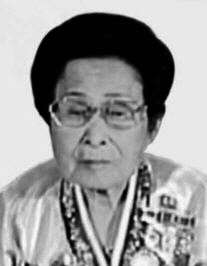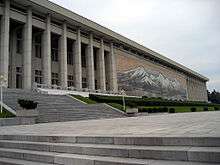Hwang Sun-hui
Hwang Sun-hui (황순희, 3 May 1919 – 17 January 2020) was a North Korean politician who served in several high-ranking positions in the Workers' Party of Korea (WPK), including in the Supreme People's Assembly and the Central Committee of the WPK. She was affiliated with the Korean Revolution Museum since 1965, and was its director since 1990.
Hwang Sun-hui | |
|---|---|
 | |
| Personal details | |
| Born | 3 May 1919 near North Hamgyong, Japanese Korea |
| Died | 17 January 2020 (aged 100) Pyongyang, North Korea |
| Cause of death | Pneumonia |
| Nationality | North Korean |
| Political party | Korean Workers' |
| Hwang Sun-hui | |
| Chosŏn'gŭl | 황순희 |
|---|---|
| Hancha | 黃順姬 |
| Revised Romanization | Hwang Sun-hui |
| McCune–Reischauer | Hwang Sunhŭi |
| IPA | [ɸwa̠ŋ sʰun.çi] |
| [1][2] | |
Career
Hwang Sun-hui was born on 3 May 1919 near the border between Japanese Korea and the Republic of China. Yonhap lists her place of birth as North Hamgyong Province,[3] although some sources such as the KCNA and the South Korean Ministry of Unification list her as being born in Helong or Yanji, China.[4][1] She served as a guerrilla in the 88th Special Independent Sniper Brigade of the Soviet Far East Command during the Second Sino-Japanese War and World War II.[5] Her duties included sewing, cooking,[3] and nursing.[6] There she met Kim Il-sung and her future husband Ryu Kyong-su.[5] Hwang returned to North Korea in November 1945.[3] She would play a key political role in the nascent North Korean state.[6]
Her first post of political significance was as the chairwoman of the provincial committee of the Korean Democratic Women's Union (KDWU) for Ryanggang Province in March 1956.[1] She was made a member of the central executive committee of the whole KDWU in August 1969, the director of its central committee in October 1971, and the vice chairwoman of the organization in December 1977.[3]
Hwang was made an alternate member in the Central Committee of the Workers' Party of Korea (WPK) in September 1961. She was elected full member in November 1969 and again in October 1980.[3] In September 2010, she was again on the central committee, this time as an alternate member.[7]
Hwang became affiliated with the Korean Revolution Museum in October 1965 when she became the chairwoman of its party committee. She was made secretary of the committee in June 1973 and again in July 1988. Hwang became the director of the museum in April 1990.[3]
Hwang was a deputy to the 3rd, 4th, 5th, 7th, 8th, 9th, 10th,[3] and 13th Supreme People's Assemblies.[1] Hwang was on the funeral committees of Kim Il-sung (1994, ranked 6th),[3] O Jin-u (1995),[1] Choe Kwang (1997, 28th), and Jon Mun-sop (1998).[3] Hwang was awarded the Order of Labor in May 1979, Order of Kim Il-sung in April 1982, and "Double Hero" in April 1992.[3]
Public image
Hwang Sun-hui was married to Ryu Kyong-su. Ryu was a hero of the Korean War, leading a brigade of the 105th Armored Division into Seoul as the first armored unit. His unit hoisted the North Korean flag at Seoul City Hall. This association with her husband gave Hwang "unrivalled rank in the party".[6] The two had a daughter, Ryu Chu-ok, who is married to Kim Chang-son, also a prominent WPK politician.[5]
Hwang was one of very few women on the Central Committee of the WPK,[8] and one of its oldest members.[9] As a former guerrilla, her membership in the central committee was considered ceremonially important.[10]
Hwang was considered one of the original supporters of the Kim dynasty.[10] All three Kims appeared with her over the decades, making her a permanent living propaganda exhibit from the early days of the Kim regime until she died. The leader of North Korea hugging Hwang was a familiar sight in the country. Kim Jong-un was seen hugging her in his first year as the supreme leader, again in 2013, and in 2017 when he visited Hwang—who by this point in her life used a wheelchair—at the Korean Revolution Museum. One defector noted, "Hwang has been so squeezed that she must not have any juice left in her".[6]
Hwang Sun-hui died at age 100 on 17 January 2020,[11] and her bier was attended by Kim Jong-un and his wife. Following her death, the Korean Central News Agency described Hwang as "a steadfast female revolutionary who dedicated her all to the accomplishment of the revolutionary cause of Juche pioneered on Mount Paekdu".[12] She was given a state funeral with the following members on her funeral committee chaired by Choe Ryong-hae:[13][14]
- Choe Ryong-hae
- Pak Pong-ju
- Kim Jae-ryong
- Ri Man-gon
- Ri Il-hwan
- Choe Hwi
- Ri Pyong-chol
- Kim Tok-hun
- Pak Thae-dok
- Pak Thae-song
- Kim Yong-chol
- Choe Pu-il
- Kim Su-kil
- Thae Hyong-chol
- O Su-yong
- Jong Kyong-thaek
- Kim Hyong-jun
- Ho Chol-man
- Ri Ho-rim
- Cho Yong-won
- Pak Jong-chon
- Kim Jong-kwan
- Im Chol-ung
- Ri Ryong-nam
- Kim Il-chol
- Ri Chu-o
- Tong Jong-ho
- Chon Kwang-ho
- Ko In-ho
- Pak Yong-il
- Pak Kyong-suk
- Ri Yong-suk
- Choe Tong-myong
- Ri Yong-rae
- Ro Kwang-sop
- Kim Jun-son
- O Il-jong
- Ri Sang-won
- Kim Ki-nam
- Ri Yong-sik
- Kim Cho-kuk
- Kim Nung-o
- Pak Jong-nam
- Ri Hi-yong
- Kim Tu-il
- Mun Kyong-dok
- Ri Chol-man
- Pak Chang-ho
- Kang Pong-hun
- Kim Song-il
- Kim Yong-hwan
- Kim Chol-sam
- Sin Yong-chol
- Ri Thae-il
- Jong Yong-kuk
- Son Yong-hun
- Pak Chol-min
- Chu Yong-kil
- Kim Chang-yop
- Chang Chun-sil
- So Hong-chan
- Son Chol-chu
- Cho Kyong-chol
- Ri Tu-song
- Kim Song-chol
- Kang Sun-nam
- Ri Tong-chun
- Ri Yong-chu
- O Kum-chol
References
- North Korea Information Portal n.d.
- North Korea Handbook 2002, p. xxx.
- North Korea Handbook 2002, p. 790.
- KCNA 2020.
- North Korea Leadership Watch 2013.
- Lee 2017.
- Lee et al. 2013, p. 28.
- Lee et al. 2013, p. 24.
- Lee et al. 2013, p. 25.
- Scalapino & Lee 1972, p. 750.
- Donga 2020.
- Yonhap 2020a.
- Yonhap 2020b.
- Choson Sinbo 2020.
Works cited
- 황순희동지의 서거에 대한 부고/조선중앙통신 보도. Choson Sinbo (in Korean). 18 January 2020. Retrieved 20 January 2020.
- 北 김정은이 직접 조문한 혁명 1세대 ‘황순희’는 누구?. Donga (in Korean). 18 January 2020. Retrieved 20 January 2020.
- "Anti-Japanese Revolutionary Fighter Hwang Sun Hui Dies". KCNA. 18 January 2020. Retrieved 22 January 2020.
- Lee Kyo-duk; et al. (2013). Study on the Power Elite of the Kim Jong Un Regime. Seoul: Korea Institute for National Unification. ISBN 978-89-8479-708-6.CS1 maint: ref=harv (link)
- Lee Young-jong (1 April 2017). "Simmering Resentment". Korea JoongAng Daily. Retrieved 21 March 2019.CS1 maint: ref=harv (link)
- North Korea Handbook. Seoul: Yonhap. 2002. ISBN 978-0-7656-3523-5.
- 황순희(여성). North Korea Information Portal (in Korean). Ministry of Unification. n.d. Retrieved 21 March 2019.
- "Kim Chang Son". North Korea Leadership Watch. 14 May 2013. Retrieved 21 March 2019.
- Scalapino, Robert A.; Lee Chong-Sik (1972). Communism in Korea: The Society. Berkeley: University of California Press. p. 750. ISBN 978-0-520-02274-4.CS1 maint: ref=harv (link)
- "N.K. leader expresses condolences for death of former anti-Japanese fighter". Yonhap. 18 January 2020a. Retrieved 18 January 2020.
- "N. Korea holds state funeral for former anti-Japanese fighter". Yonhap. 20 January 2020b. Retrieved 20 January 2020b.
